As an Amazon Associate KitchenwareSets.com earns from qualifying purchases.
11 Japanese Kitchen Island Ideas for a Minimalist Home
Craving a kitchen that feels like a sanctuary, not a source of stress? You’re not alone. Many of us dream of a space that is both a highly efficient workspace for cooking and a tranquil retreat from the chaos of daily life. The challenge is achieving that perfect balance between minimalist beauty and practical, everyday function. How do you create a kitchen that feels calm and clutter-free without sacrificing the storage and counter space you desperately need?
This is where the principles of Japanese design, beautifully blended with Scandinavian practicality, offer a brilliant solution. A Japanese kitchen island combines the serene minimalism of Japanese aesthetics with the practical functionality of Scandinavian design. It focuses on natural materials, clean lines, and intelligent storage to create a kitchen that is not only stunning to look at but also a joy to use, serving as the calm, organized heart of your home.
This guide will walk you through 11 tangible, inspiring ideas to help you design the perfect Japanese-style kitchen island. We’ll explore specific materials, layouts, and design choices that will transform your kitchen into a peaceful and functional space, proving that you don’t have to choose between style and substance.
Craving a Calm, Clutter-Free Kitchen? Here’s How a Japanese Island Can Redefine Your Space
A Japanese kitchen island blends the serene minimalism of Japanese aesthetics with the practical functionality of Scandinavian design. It acts as the perfect solution for the common struggle of creating a kitchen that is both a practical workspace and a tranquil retreat. By focusing on natural materials, clean lines, and smart storage, it creates a kitchen that is both beautiful and highly efficient. This design philosophy, often called “Japandi,” positions the kitchen island as the heart of this transformation, turning your kitchen into a space that feels uncluttered, natural, and deeply calming. These 11 ideas are curated from core Japanese and Scandinavian design principles, providing a clear roadmap to achieving this coveted aesthetic in your own home.
11 Japanese Kitchen Island Ideas for a Tranquil and Functional Home
To find specific, actionable, and visually inspiring ideas for designing a Japanese-style kitchen island, explore these core principles of Japandi design. Each of the following 11 points represents a key element, complete with practical advice and stunning visuals to guide your own kitchen project. These ideas are a synthesis of expert interior design trends and timeless aesthetic principles, providing a comprehensive guide to creating an island that is both a functional powerhouse and a serene centerpiece. From embracing natural materials to optimizing your layout, these tips will help you craft the tranquil and efficient kitchen you’ve been dreaming of.
1. Embrace the Warmth of Natural Wood
The best way to incorporate natural warmth is by using wood as the primary material for your island’s countertop or base. Woods like light oak keep a space bright and airy, while darker woods such as American walnut add depth and sophistication. This focus on natural materials is a cornerstone of both Japanese and Scandinavian design, creating an instant connection to nature and a sense of calm.
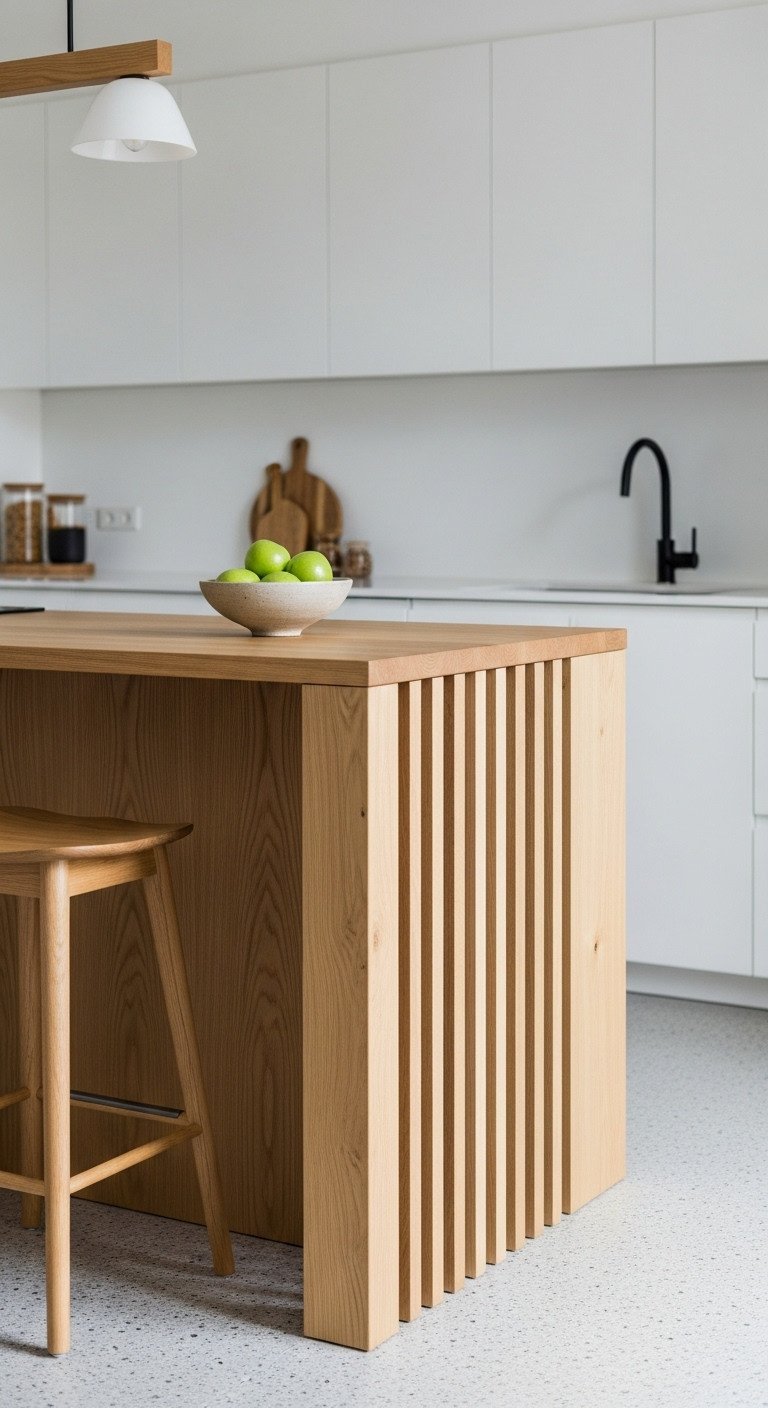
Pin this natural wood inspiration for your dream kitchen!
- Materials Needed:
- Wood slab or butcher block (e.g., light oak, walnut)
- Cabinet base for the island
- Wood veneer or slatted panels (optional, for sides)
- Fine-grit sandpaper
- Food-safe wood oil or sealant
- Tack cloth and soft rags
- Step-by-Step Directions:
- Select your wood. Light oak or maple keeps the space bright and airy, while dark walnut adds depth and sophistication.
- Construct or purchase a simple, flat-front cabinet base for your island.
- Securely attach your wood countertop to the base. For a high-end look, consider a waterfall edge where the wood grain continues down the side.
- Sand the wood surface until it is perfectly smooth, moving with the grain.
- Wipe away all dust with a tack cloth.
- Apply several thin coats of a high-quality, food-safe wood sealant, allowing for proper drying time between coats as per the manufacturer’s instructions. This is crucial for protecting the wood from moisture and stains.
Pro-Tip: Always test your sealant on a small, inconspicuous area of the wood first to ensure you’re happy with the final color and finish before applying it to the entire surface.
2. Prioritize Clean Lines and Unadorned Simplicity
To achieve an uncluttered look, choose flat-front, handle-less cabinetry and smooth, unadorned surfaces. This approach eliminates visual noise and puts the focus on the form and material of the island itself. Hardware like push-to-open latches or integrated pulls maintains this sleek aesthetic, creating a seamless and sophisticated appearance that is central to minimalist design.
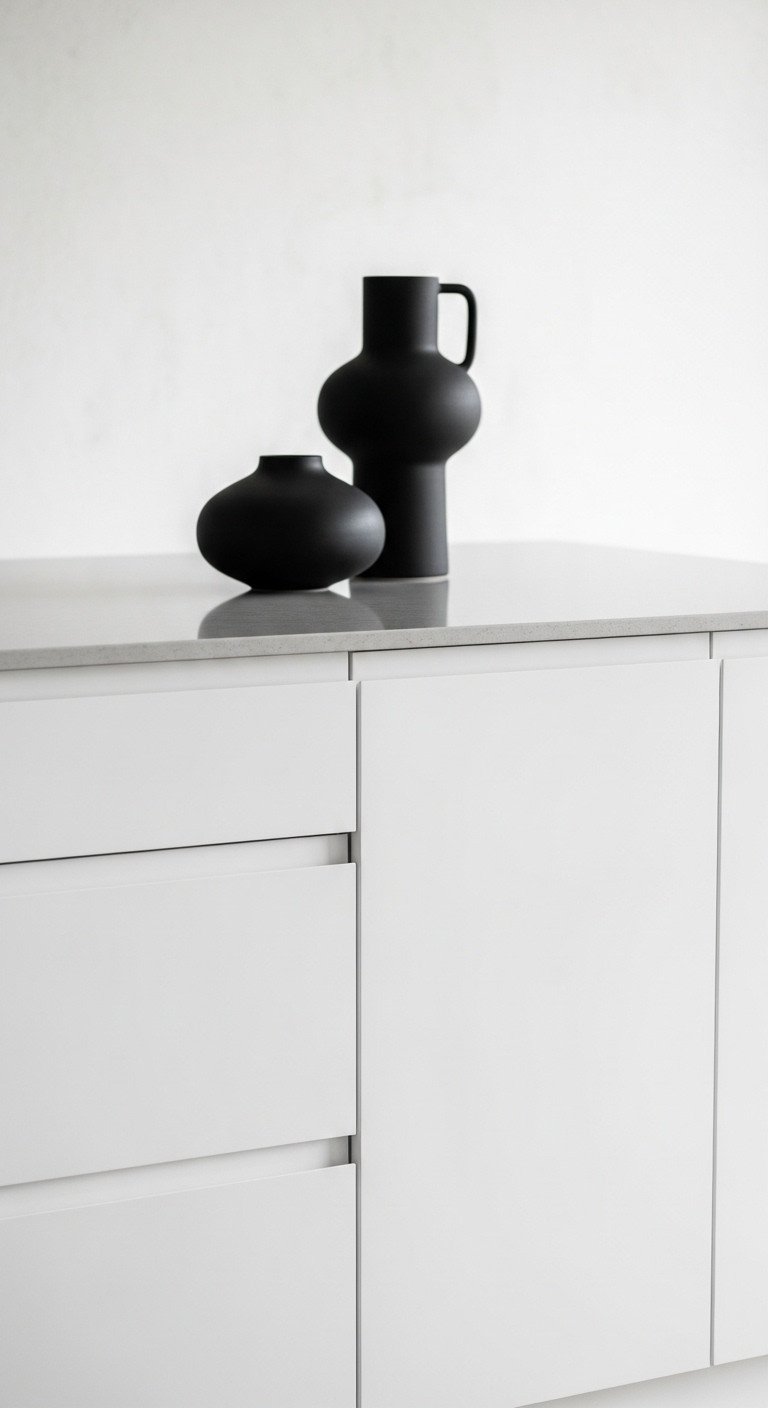
Save this sleek, minimalist design to your ‘Modern Kitchen’ board!
- Materials Needed:
- Flat-panel cabinet doors (MDF or solid wood)
- Push-to-open latch hardware
- Concealed hinges
- Primer and semi-gloss or matte paint
- Spackle or wood filler
- Fine-grit sandpaper
- Step-by-Step Directions:
- If updating existing cabinets, remove the old doors and all hardware. Fill any handle holes with wood filler, let dry, and sand smooth.
- Prime and paint your new or existing cabinet doors in a neutral color. Multiple thin coats will provide the smoothest finish.
- Install concealed hinges on the doors and the island base according to the manufacturer’s instructions.
- Attach a push-to-open mechanism inside the cabinet frame. These magnetic or mechanical latches allow you to open the door with a simple press, eliminating the need for external hardware and creating that seamless, clean look.
Lesson Learned: Not all push-to-open hardware is created equal. Invest in a quality system to ensure your cabinet doors open smoothly and reliably for years to come.
3. Integrate Smart, Hidden Storage Solutions
To maximize storage while maintaining a minimalist look, incorporate clever solutions like pull-out organizers, deep drawers with dividers, and panel-ready appliances. These features keep your countertops free of clutter by providing a designated, easily accessible place for everything from spices to recycling bins. A panel-ready dishwasher or beverage fridge can disappear completely, blending seamlessly into the cabinetry.
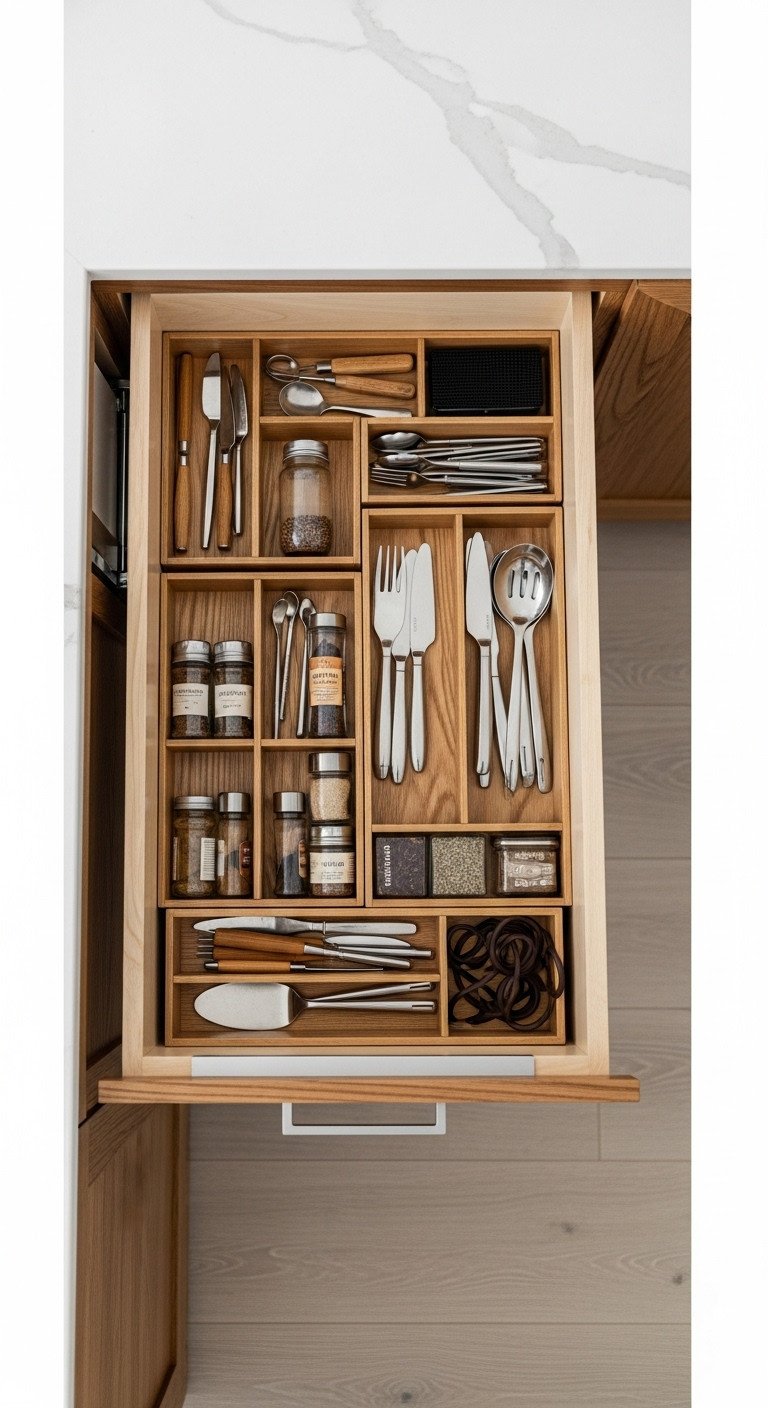
Get inspired by this genius storage hack! Save it now.
- Materials Needed:
- Pull-out cabinet organizer kit (for trash, spices, or pans)
- Deep drawer dividers (bamboo or wood are ideal)
- Panel-ready appliance (e.g., dishwasher, beverage fridge)
- Custom cabinet panel to match your island
- Step-by-Step Directions:
- Designate specific zones within your island: one cabinet for waste and recycling, a deep drawer for pots and pans, a narrow cabinet for spice racks.
- Install a heavy-duty pull-out cabinet organizer. These systems slide out smoothly, giving you easy access to everything inside without having to dig around. A double-bin system for trash and recycling is a game-changer.
- Use expandable drawer dividers in your drawers to create custom compartments for utensils, cutlery, and cooking tools. This prevents items from sliding around and keeps everything in its place.
- For the ultimate seamless look, consider a panel-ready appliance. You can affix a custom cabinet front to it, making it completely disappear into the island’s design.
Pro-Tip: Before you buy any organizer, meticulously measure the interior dimensions of your cabinets and drawers (width, depth, and height) to ensure a perfect fit.
4. Layer Lighting with Minimalist Fixtures
The right lighting involves layering different sources, including statement pendant lights above the island and functional task lighting elsewhere. Choose fixtures with simple shapes and natural materials like wood, paper, or matte metal. Installing a dimmer switch allows you to control the ambiance, shifting from bright, functional light for cooking to a soft, warm glow for relaxing.
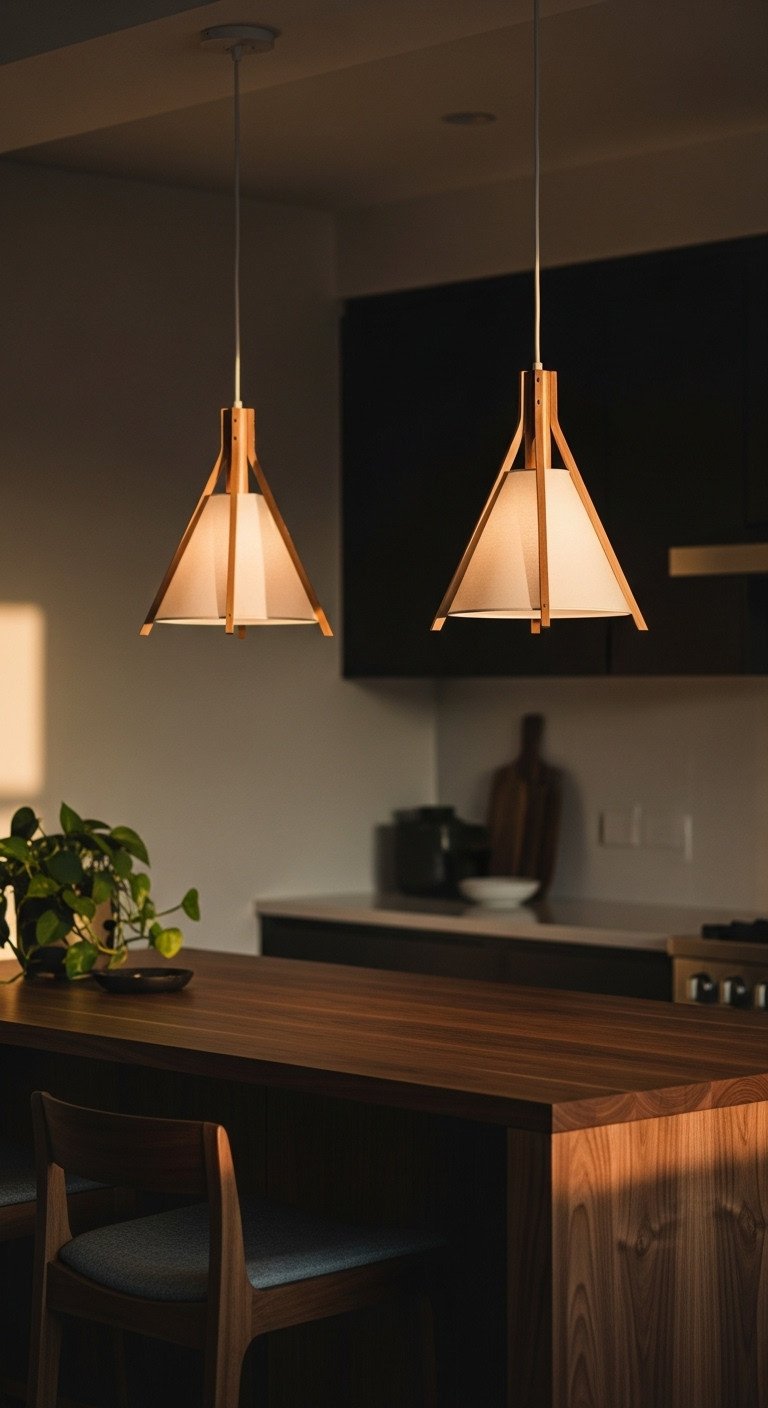
Love this look? Pin these perfect pendant lights!
- Materials Needed:
- Minimalist pendant light fixtures (2 or 3)
- Warm-tone LED bulbs (2700K is ideal)
- Dimmer switch
- Under-cabinet LED strip lighting (for task lighting)
- Ceiling electrical box and wiring
- Step-by-Step Directions:
- Choose your statement piece. Select one, two, or three pendant lights with simple shapes and natural materials like wood, paper, or matte black metal. Hang them 30-36 inches above the island countertop.
- Install under-cabinet lighting around the perimeter of your kitchen. This is your task lighting, essential for food prep, and it keeps the island surface free for its own statement fixtures.
- Use warm-tone LED bulbs in all your fixtures. A color temperature of around 2700K creates a cozy, inviting glow that is central to the Japandi aesthetic.
- Install a dimmer switch for your pendant lights. This gives you complete control over the ambiance, allowing you to switch from bright, functional light to a soft, relaxing glow.
Pro-Tip: For a long island, use three smaller pendants. For a smaller, square island, a single larger pendant often makes a bigger impact. The rule of odds (1 or 3) is often more visually appealing.
5. Use a Neutral Color Palette with Warm Accents
The right color combination involves building a base of soft, neutral colors and introducing warmth through natural wood tones and earthy accents. Shades like soft white, cream, and pale gray create a calm and serene backdrop. Pairing these with elements like a wood countertop, oak flooring, or stoneware pottery prevents the space from feeling cold and adds essential warmth and texture.
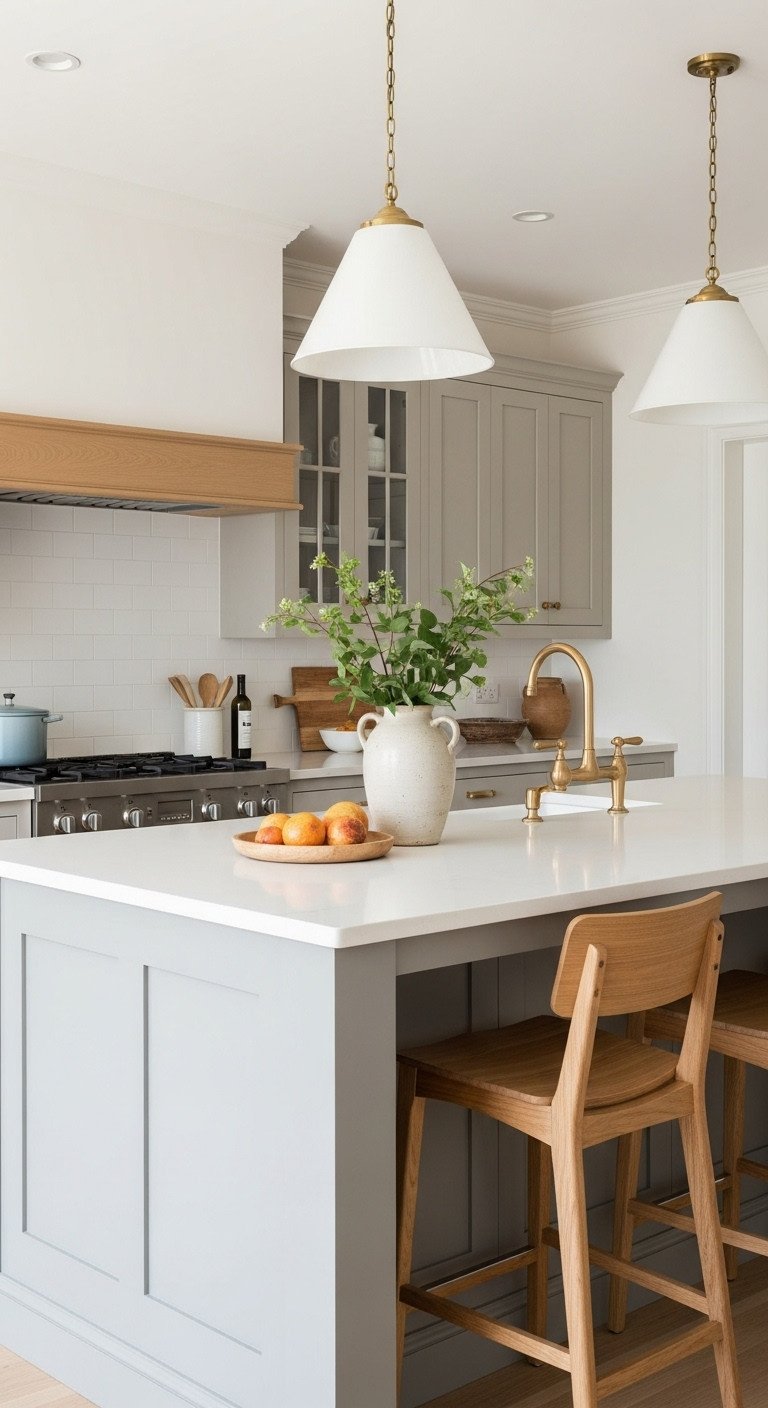
Pin this calming color palette for your next project!
- Materials Needed:
- High-quality cabinet paint in a neutral shade (e.g., Benjamin Moore ‘Simply White’, Sherwin-Williams ‘Agreeable Gray’)
- Paint primer
- Paint rollers and brushes
- Painter’s tape
- Drop cloths
- Step-by-Step Directions:
- Choose your base neutral. Soft whites, creamy off-whites, or pale greiges create a perfect, calming backdrop.
- Prep your island for painting by cleaning it thoroughly, lightly sanding, and applying a coat of primer.
- Apply 2-3 coats of your chosen neutral color, allowing ample dry time between coats. A high-quality cabinet enamel will provide the most durable finish.
- Introduce warmth through natural materials. Pair your painted island with a butcher block countertop, light oak flooring, or wooden bar stools. These elements prevent the neutral palette from feeling cold or sterile.
- Add subtle earthy accents through decor, like stoneware pottery, a linen tea towel, or a dark bronze faucet.
Lesson Learned: Always get paint samples and view them in your kitchen at different times of the day. The way natural and artificial light hits the color can dramatically change its appearance.
6. Make a Statement with an Oversized or Live-Edge Island
To create a dramatic focal point, choose an oversized island with a unique countertop, like a thick slab of live-edge wood. The raw, organic edge of a material like American walnut introduces a powerful piece of nature into the kitchen, serving as both a functional surface and a work of art. This approach celebrates natural beauty and craftsmanship, making the island the undeniable centerpiece of the room.
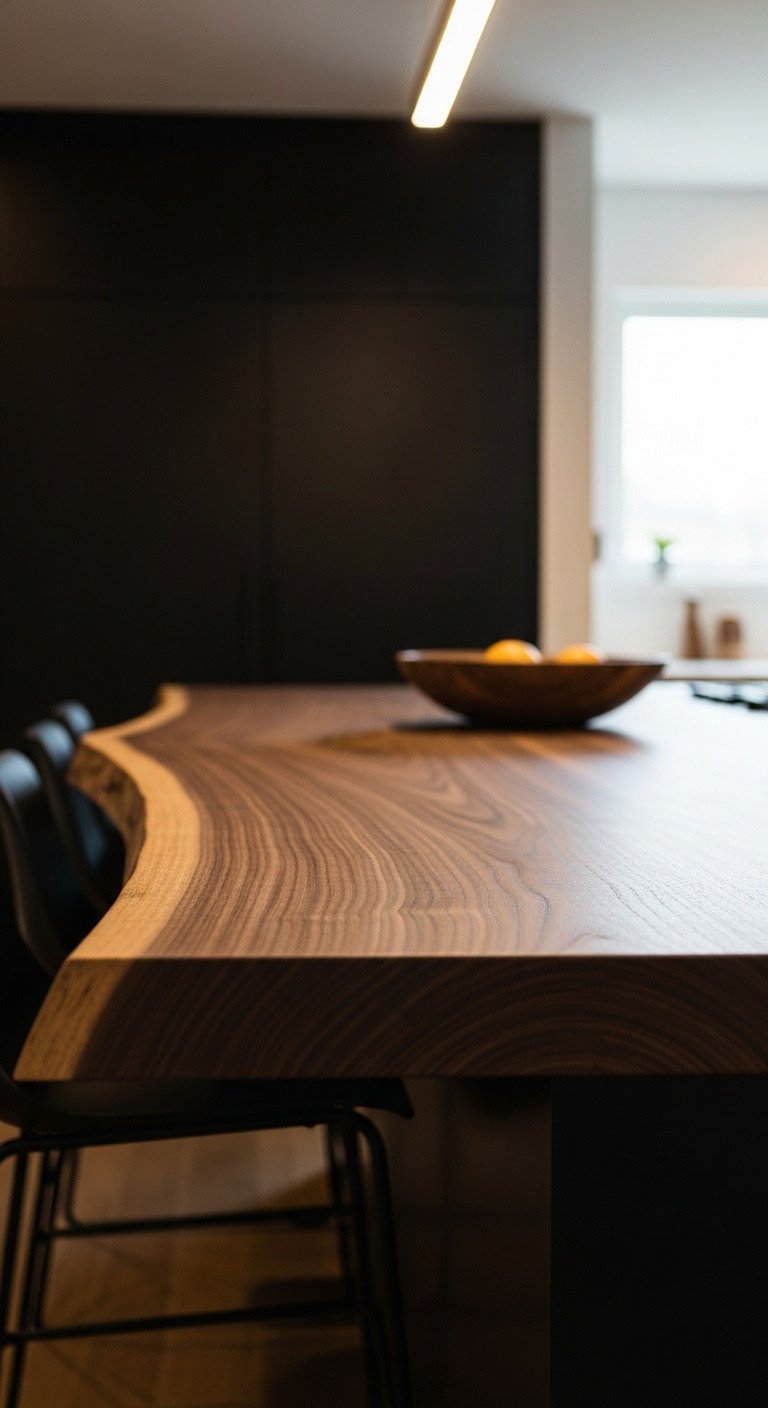
Save this stunning live-edge island idea to your ‘Dream Home’ board!
- Materials Needed:
- Large live-edge wood slab
- Sturdy island base capable of supporting significant weight
- Heavy-duty brackets or supports
- Epoxy resin (for filling any cracks or voids)
- Orbital sander with multiple grit sandpapers
- Hardwax oil finish
- Step-by-Step Directions:
- Source your slab. Look for a reputable supplier of live-edge wood. Measure your space carefully to ensure the oversized piece will fit comfortably with adequate clearance.
- Flatten the slab. This may require professional help or a router sled for a perfectly level surface.
- Fill any large cracks or knots with a clear or black epoxy for a smooth, durable finish.
- Sand the entire surface, starting with a low grit (like 80) and working your way up to a very fine grit (220 or higher) for a silky-smooth feel.
- Apply a high-quality hardwax oil finish. This type of finish penetrates the wood, protecting it from within while maintaining a natural look and feel, perfectly aligning with the Japandi aesthetic.
Pro-Tip: Ensure your island base is engineered to support the immense weight of a solid wood slab. Reinforcing a standard base or having one custom-built is often necessary.
7. Embrace Imperfection with Wabi-Sabi Inspired Textures
To incorporate the Wabi-Sabi philosophy, choose materials with natural, imperfect textures like textured concrete, honed stone, or wood with a visible grain. This Japanese concept finds beauty in imperfection and authenticity. An uneven concrete surface or handmade ceramic accessories add soul and character to the kitchen, creating a space that feels lived-in and unique rather than sterile.
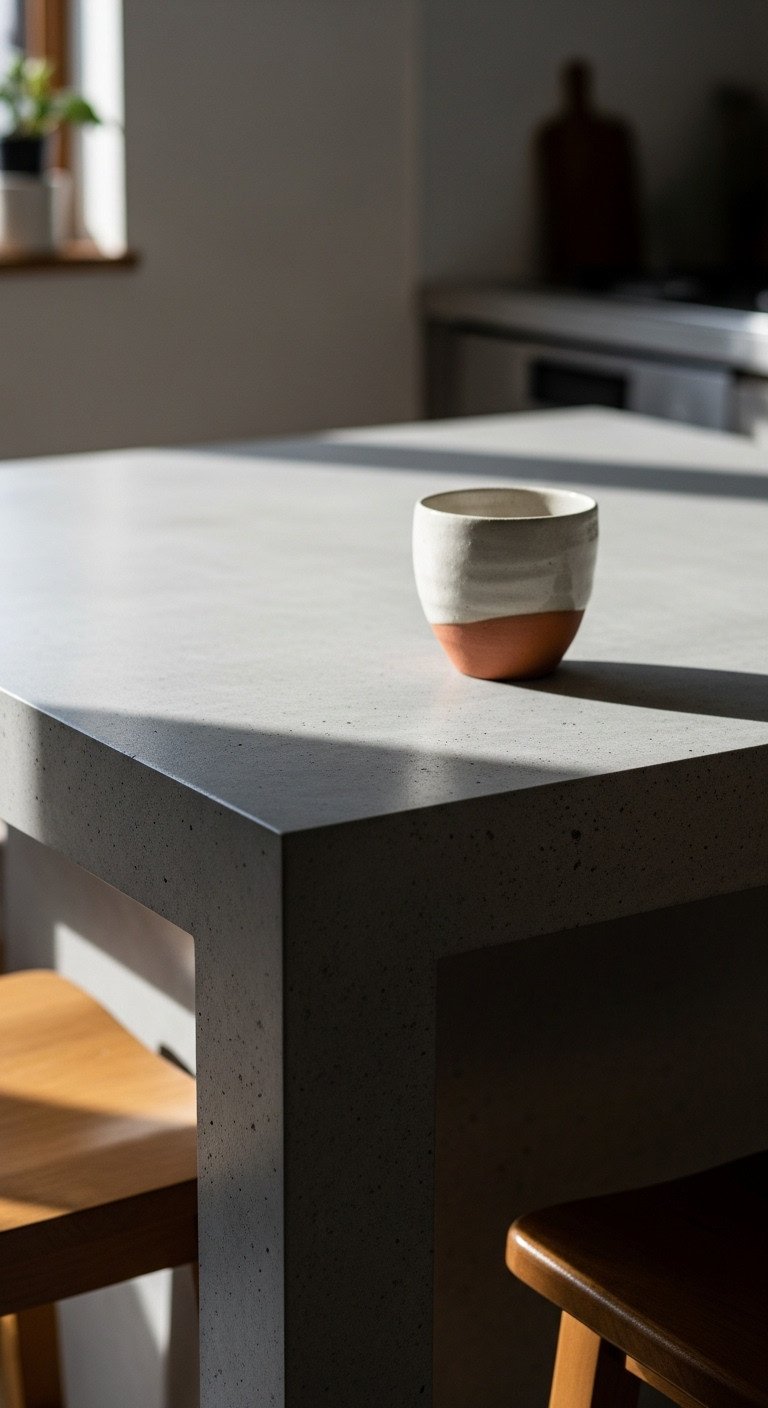
Pin this beautifully imperfect idea for a touch of soul in your kitchen.
- Materials Needed:
- Concrete countertop mix
- Melamine for building the mold
- Silicone caulk
- Reinforcing mesh
- Concrete sealer (food-safe, matte finish)
- Trowel
- Step-by-Step Directions:
- Build a mold for your countertop on top of the island base using melamine sheets, sealing the inside seams with silicone caulk.
- Mix the concrete according to the package directions. For a more Wabi-Sabi feel, you can add pigments to create subtle color variations.
- Pour the concrete into the mold, placing the reinforcing mesh in the middle of the pour for strength.
- Use a trowel to level the surface, but don’t overwork it. Allow for slight variations and “trowel marks” to remain, as these create the desired imperfect texture.
- Let the concrete cure completely (this can take several days or weeks).
- Remove the mold and apply several coats of a high-quality, food-safe matte concrete sealer to protect it from stains and acids.
Lesson Learned: A DIY concrete countertop is a rewarding but challenging project. If you’re new to working with concrete, practice on a small sample piece first to get a feel for the process and the final texture.
8. Create a Sophisticated Balance with Black and White
To use a high-contrast palette effectively, pair a dark, almost black, island base with a crisp white countertop. This creates a sophisticated and balanced look that feels both modern and timeless. Using a dark-stained oak for the base adds texture and warmth, preventing the black from feeling flat, while a pure white quartz top provides a durable and bright work surface.
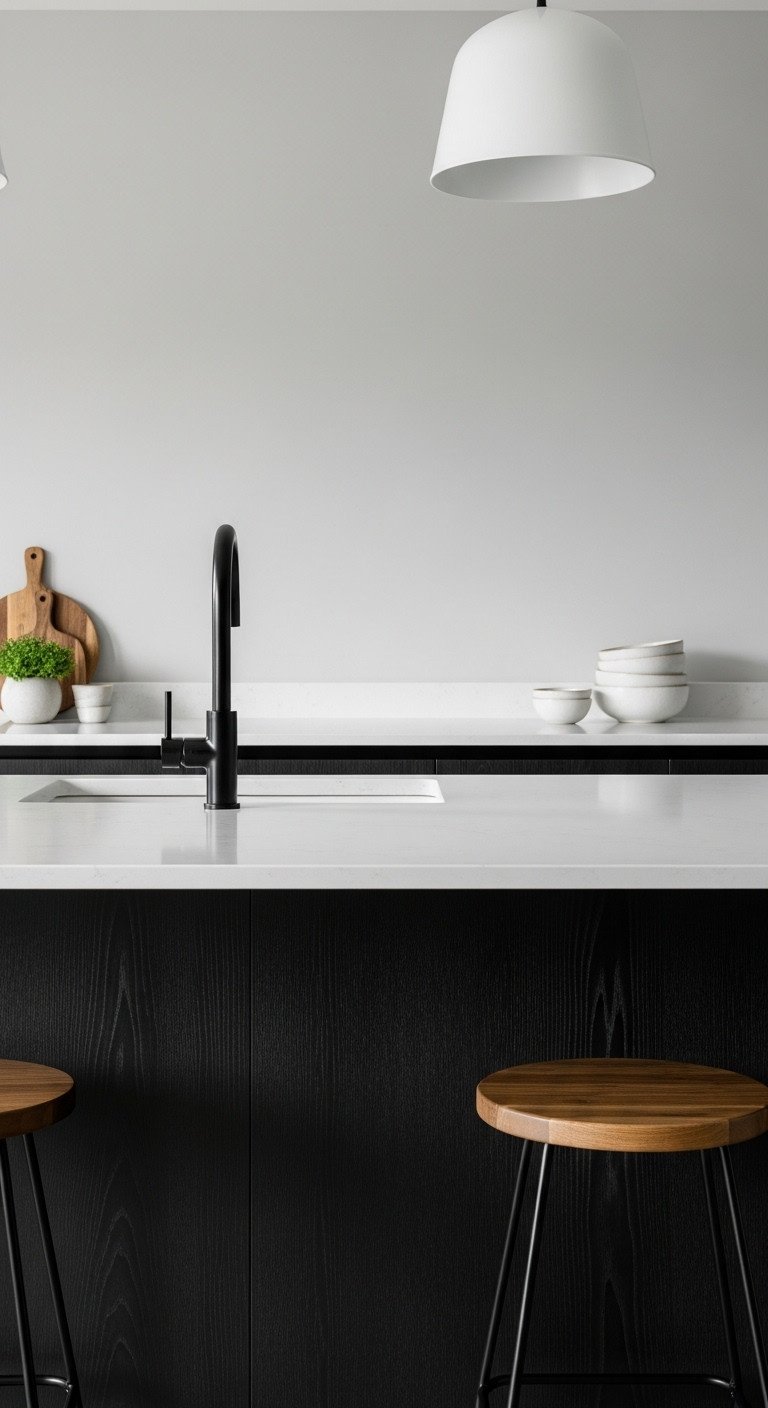
Save this bold and balanced look for a sophisticated kitchen!
- Materials Needed:
- Oak or maple island base
- Black wood stain or matte black cabinet paint
- Pre-stain wood conditioner (if staining)
- Polyurethane topcoat (matte finish)
- White countertop material (e.g., quartz, marble, solid surface)
- Tack cloths and rags
- Step-by-Step Directions:
- Start with a wood island base. Sand it smooth to prepare for finishing.
- To achieve a deep, even black, first apply a pre-stain wood conditioner. This prevents blotchiness.
- Apply a high-quality black wood stain according to the manufacturer’s directions. Alternatively, for a more opaque look, use a durable matte black cabinet paint.
- Protect the finish with 2-3 coats of a matte polyurethane topcoat. This adds durability without adding unwanted shine.
- Top the dark base with a clean, bright white countertop. Quartz is an excellent choice as it’s durable, non-porous, and available in pure white shades. The sharp contrast creates a visually stunning focal point.
Pro-Tip: To soften the high contrast, incorporate natural wood elements elsewhere, such as in open shelving above the island or in the bar stools. This bridges the gap between the black and white.
9. Add Subtle Texture with Natural Stone
To add texture without using loud patterns, select a natural or engineered stone with subtle veining and a honed or matte finish. Materials like quartzite or advanced surfaces like Dekton offer the look of natural stone with enhanced durability. A “waterfall” edge, where the stone continues seamlessly down the sides of the island, is a hallmark of high-end design and adds a touch of quiet luxury.
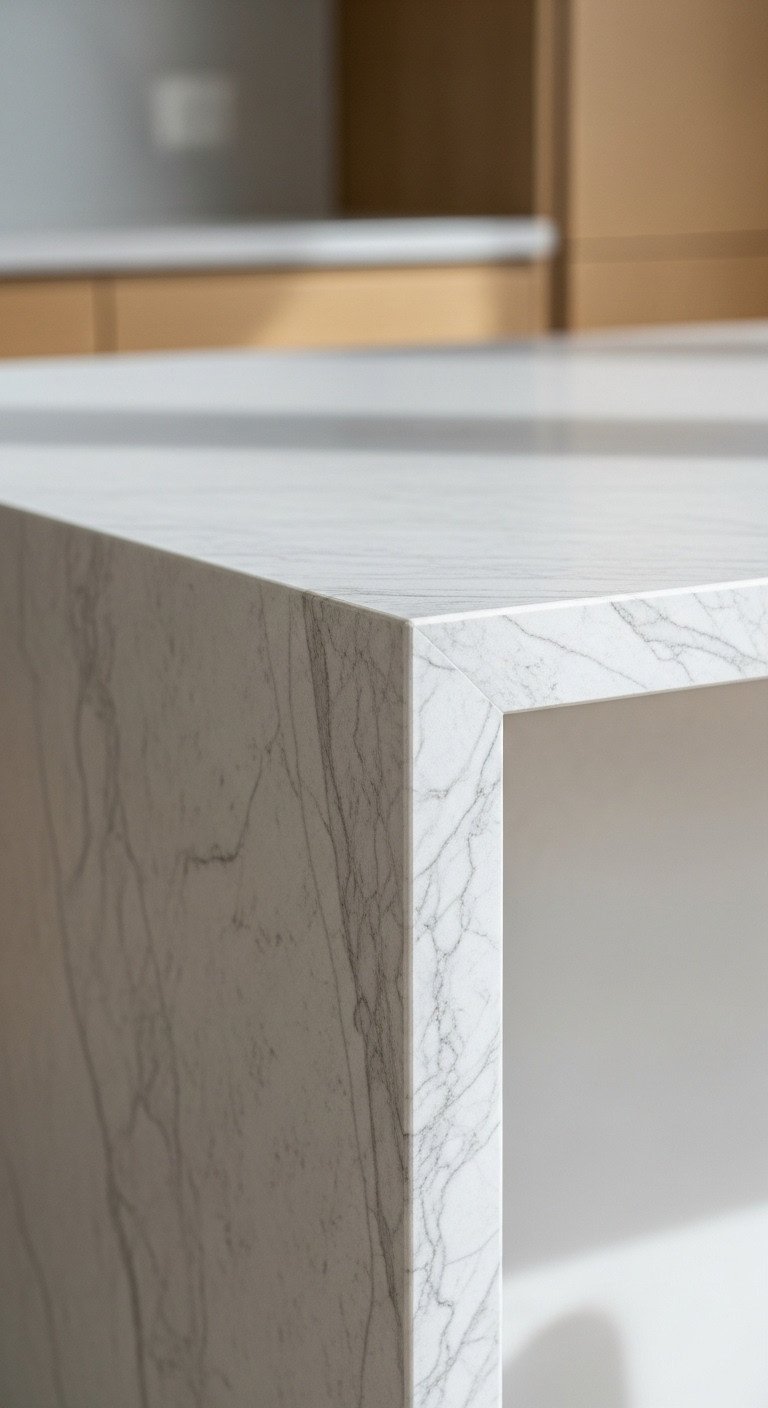
Pin this elegant stone island for a touch of quiet luxury.
- Materials Needed:
- Stone slabs (e.g., honed marble, quartzite, or an engineered stone like Dekton)
- Plywood subtop for the island base
- Professional stone fabricator/installer
- Step-by-Step Directions:
- Choose a stone with subtle, gentle veining. Avoid dramatic, high-contrast patterns that can overwhelm a minimalist space. Honed or matte finishes often work better than polished ones for a softer, more organic feel.
- Engineered stones like Dekton or certain quartz designs are excellent choices as they offer the look of natural stone with superior durability and stain resistance.
- Work with a professional fabricator. They will create a template of your island and cut the stone precisely.
- For the ultimate statement, opt for a “waterfall” design where the stone continues from the countertop down one or both sides of the island to the floor. This requires a mitered edge for a seamless look and is a hallmark of high-end Japandi design.
Pro-Tip: When selecting your slab in person, ask to see the entire piece. The patterns can vary significantly from one end to the other, and you’ll want to choose the section you find most beautiful for the most prominent part of your island.
10. Bring Nature Indoors with a Touch of Greenery
The simplest way to reinforce the connection to nature is to place a single, impactful piece of greenery on the island. Instead of multiple small pots, opt for a tall vase with a few sculptural branches or a simple potted plant like a snake plant. This minimalist approach, inspired by the Japanese art of Ikebana, adds a touch of life and vibrant color without creating clutter.
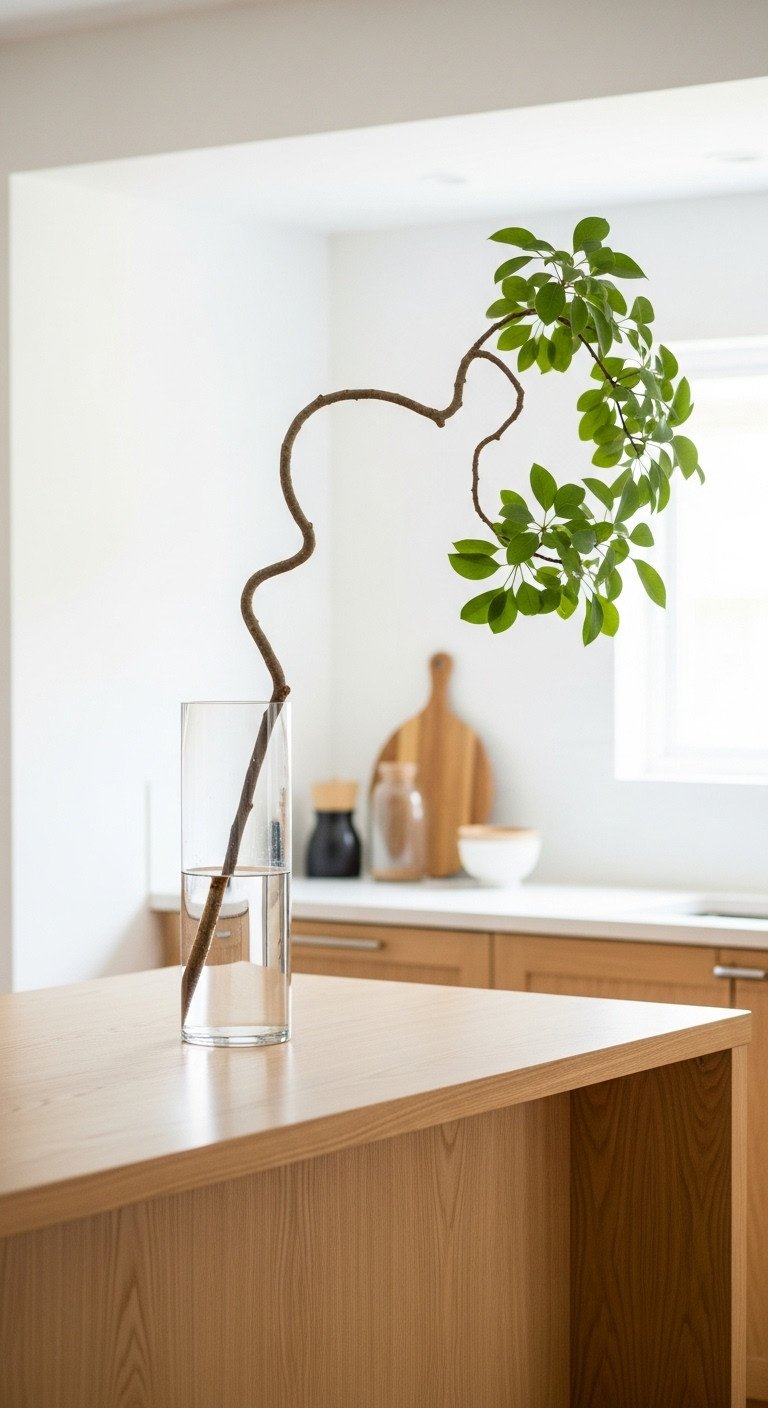
Save this simple idea to bring life to your kitchen!
- Materials Needed:
- Large, minimalist vase (glass, ceramic, or stoneware)
- Sculptural branches (e.g., olive, eucalyptus, cherry blossom) or a low-light tolerant indoor plant
- Small, elegant planter pot
- Step-by-Step Directions:
- Choose quality over quantity. Instead of a collection of small pots, opt for a single, impactful statement piece.
- For a long-lasting, low-maintenance option, place a few tall, sculptural branches in a beautiful vase with water. This is a very common practice in Japanese Ikebana and fits perfectly. Change the water weekly.
- If you prefer a potted plant, choose one that is both beautiful and tolerant of typical kitchen conditions. A snake plant or ZZ plant are excellent, low-maintenance choices that have a strong vertical form.
- Select a planter that complements your island’s design. A simple ceramic or stoneware pot in a neutral color is a perfect choice. Ensure it has drainage holes.
Pro-Tip: Place the plant or vase off-center on your island. This asymmetrical placement is more dynamic and natural-looking than a perfectly centered arrangement.
11. Design for Functional Layout and Effortless Flow
To ensure your kitchen is easy to navigate, plan for at least 42 inches of clear walkway space around the working sides of the island. This is a fundamental rule of functional kitchen design. Before finalizing your island’s size and placement, consider your daily “work triangle”—the path between the sink, stove, and refrigerator—to ensure the island improves your workflow rather than obstructing it.
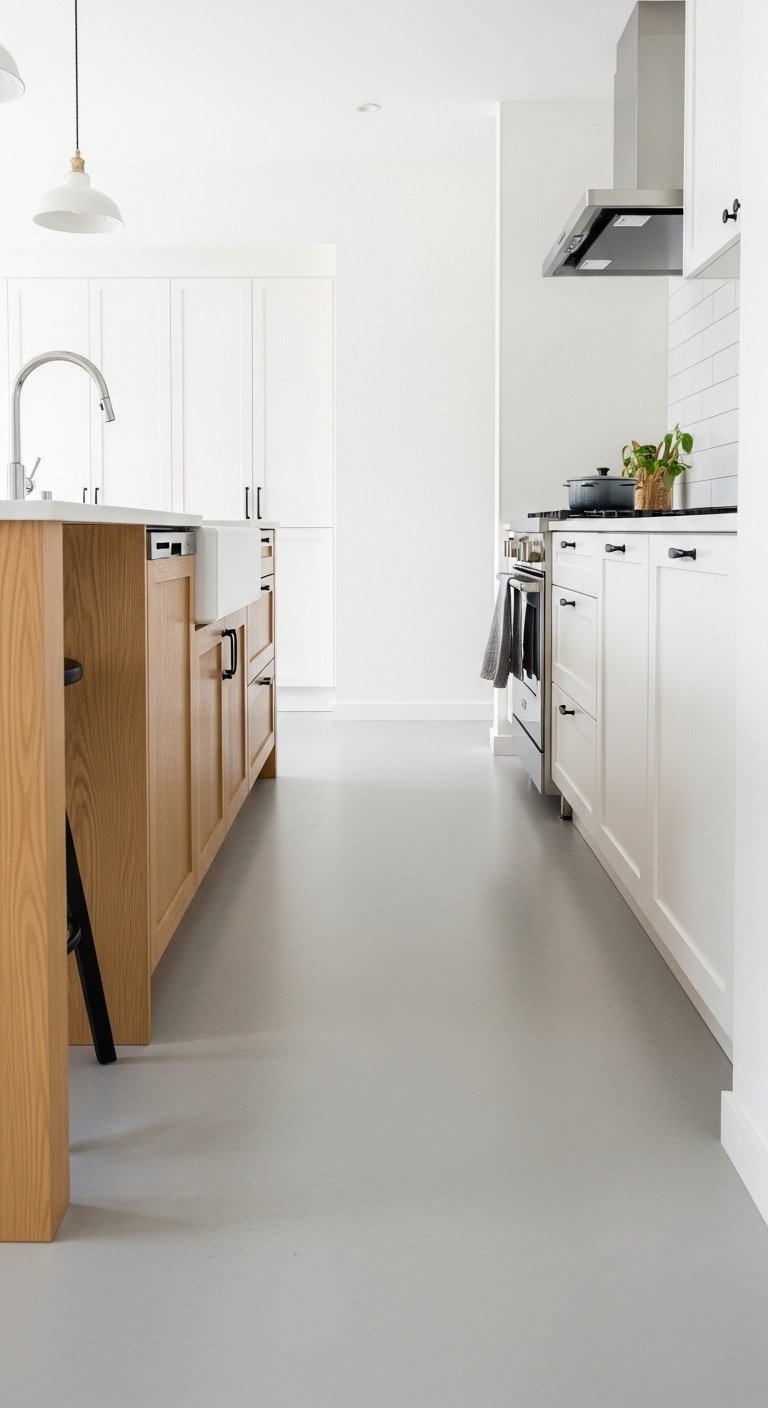
Pin this essential layout tip for a perfectly functional kitchen!
- Materials Needed:
- Measuring tape
- Painter’s tape or cardboard boxes
- Step-by-Step Directions:
- Before committing, map out the island’s footprint on your kitchen floor using painter’s tape or cardboard boxes to simulate its size.
- Follow the 42-inch rule. Aim for at least 42 inches of clear walkway space on all working sides of the island (the sides with the sink, stove, etc.). This allows for doors to open and for two people to pass each other.
- For seating areas, allow more space. If you have bar stools, you’ll need at least 48 inches of clearance behind them so people can walk by comfortably when someone is seated.
- Consider your “work triangle”—the path between your sink, refrigerator, and stove. The island should facilitate this flow, not obstruct it. Sometimes, placing the sink or a cooktop on the island can dramatically improve the kitchen’s ergonomics.
Lesson Learned: Live with your cardboard “mock-up” for a few days. Go through your daily routine of cooking, cleaning, and unloading groceries. This is the best way to feel out any potential bottlenecks or awkward spots before it’s too late.
Key Takeaways: Your Quick Guide to a Japandi Kitchen Island
Here is a scannable list summarizing the core principles for easy recall and reinforcement of the most important information from this post.
- Prioritize Natural Materials: Center your design around warm woods like oak or walnut, and complement with stone or ceramic.
- Simplicity is Key: Opt for flat-front, handle-less cabinets and unadorned surfaces for a clean, minimalist look.
- Storage Must Be Smart: Integrate hidden solutions like pull-out organizers and panel-ready appliances to keep countertops clutter-free.
- Balance Form and Function: Ensure there is adequate clearance (at least 42 inches) around the island for effortless workflow and movement.
- Bring Nature In: Complete the serene atmosphere with a simple touch of greenery, like a sculptural branch or a single plant.
People Also Ask About Japanese Kitchen Islands
What is a Japandi kitchen?
A Japandi kitchen is a design style that harmoniously blends Japanese minimalism with Scandinavian functionality. It emphasizes natural materials like wood and stone, clean lines, neutral color palettes, and a clutter-free, organized space. The goal is to create a kitchen that is both highly practical and a serene, calming environment.
What is replacing the kitchen island in 2025?
While traditional islands aren’t disappearing, the concept is evolving, with many designers in 2025 favoring freestanding worktables or more integrated, furniture-like islands. The Japandi-style island, with its focus on clean lines and natural materials, remains a very current and timeless choice that aligns perfectly with these modern trends toward lighter, more versatile pieces.
Why are people getting rid of kitchen islands?
Some homeowners are moving away from kitchen islands because they can take up significant floor space in smaller kitchens or make a space feel dated if poorly designed. The modern solution is not to eliminate islands, but to choose smarter, streamlined designs like those in the Japandi style that enhance function without sacrificing an open, airy feel.
How much space do you need for a Japanese-style kitchen island?
For a functional kitchen island, you should have at least 36 to 42 inches of clear floor space around it. This ensures you can comfortably open appliance doors and move around without feeling cramped. A minimalist Japanese-style island is well-suited for various room sizes because its design can be scaled correctly without bulky ornamentation.
Final Thoughts
Creating a Japanese-inspired kitchen island is about more than just aesthetics; it’s about crafting a space that feels calm, organized, and deeply connected to nature. By focusing on simple materials, clean lines, and smart functionality, you can transform the heart of your home into a tranquil sanctuary.
Which of these ideas has inspired you the most for your own kitchen? Let us know in the comments below.
Last update on 2025-10-14 at 23:21 / Affiliate links / Images from Amazon Product Advertising API
